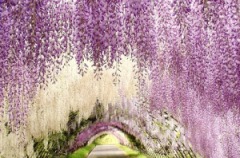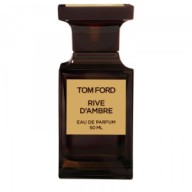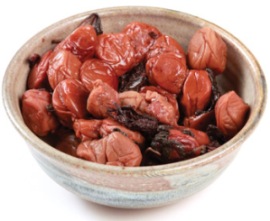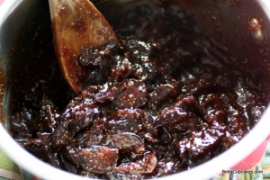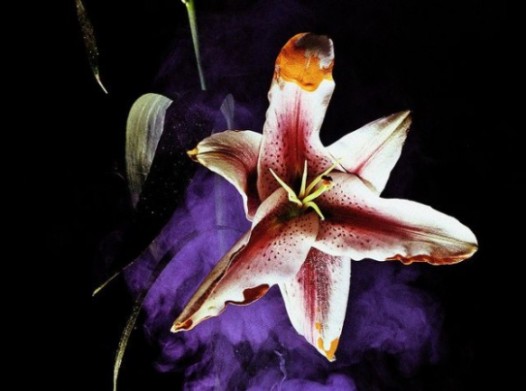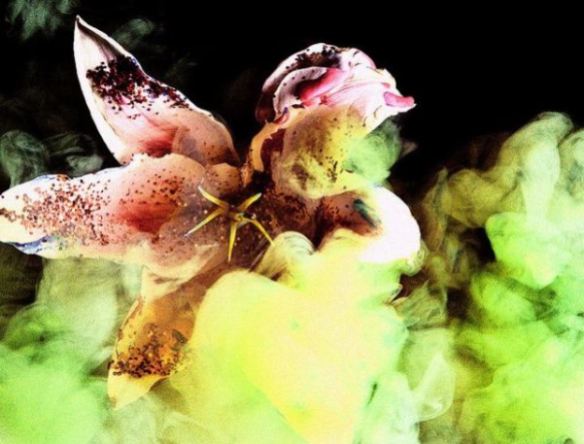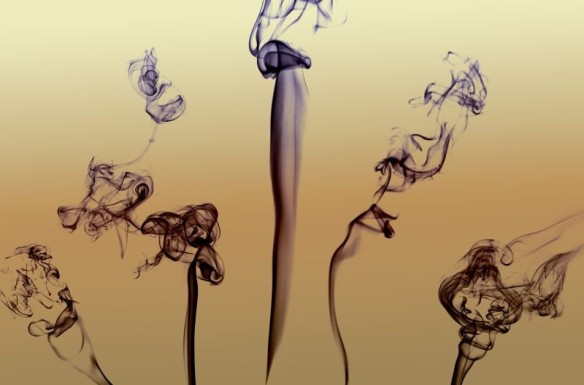A gentle veil of sweetened, creamy white flowers. That’s the essence of Fleur de Chine, the latest Private Blend fragrance from Tom Ford. It is part of a brand-new collection of perfumes within his Private Blend line that were released in July 2013. The collection is called Atelier d’Orient, and consists of four fragrances: Shanghai Lily, Plum Japonais, Rive d’Ambre, and Fleur de Chine.
According to the Moodie Report, Tom Ford’s inspiration for Fleur de Chine was the Asian cinematic femme fatale. As Ford apparently told the site:
‘For Fleur de Chine, I imagined the romantic and mysterious women from Asia’s cinematic past – from the ’30s femme fatale in a cheongsam and dark lipstick, to the ’60s Hong Kong heroine of In the Mood for Love [….] I wanted to capture that fascinating, exquisite and slightly scandalous femininity.’
Fleur de Chine is an eau de parfum that was created by Rodrigo Flores Roux of Givaudan, and its full set of notes — as compiled from the Moodie Report, Fragrantica and Surrender to Chance — are:
HuaLan flower, star magnolia, tea blossom, clementine, bergamot, hyacinth, jasmine tea, lilac, syringa, plum, tea rose, wisteria, white peach, peony, hinoki, Chinese cedarwood, amber, Laotian benzoin, styrax and vetiver.
It might be useful to go through a few of those notes. As Fragrantica explains, Hinoki is a type of light-coloured cypress prized in Japan that emits an aroma of evergreen with lemon. The “HuaLan flower” is a bit more complicated to explain. A Google search brought up the following results: Mo Li Hua Nan, Bai He Hua Lan, Yu Lan Hua, and Hua Lan. The names all seem to be different variations for the same sort of flowering tea where woody-ish-looking, green tea leaves are wrapped around night-blooming jasmine petals in the shape of a ball. I actually tried a number of these in China; you drop the dried ball into hot water and it slowly blooms, just like a flower, emitting a floral aroma infused with that of tea leaves.
I had problems testing Fleur de Chine because it feels like a floral will o’ the wisp with notes dancing in the air just out my reach. I think I have a relatively decent nose, but Fleur de Chine often felt just too nebulous and vague to pull apart. In fact, I initially put some on, then felt as though the fragrance was starting to die on my skin within less than 10 minutes. So I applied another good smear, and then two more, for a total of 5 really big smears! I felt as though I were chasing the notes, and it was incredibly frustrating. My second time around, using my regular, normal application of about 2 to 2.5 really big smears, the fragrance felt even simpler. Alas, in all cases, Fleur de Chine essentially dissolved on itself, and became a rather singular floral fragrance that was extremely lovely to sniff and actually quite seductive at times, but wholly without distinction, body, or complexity.
So, let’s start with my first attempt to get to the heart of Fleur de Chine. The fragrance opens on my skin with light, gauzy florals dominated by lilac and hyacinth. The scent is simultaneously watery and a little bit powdery. A minute later, a lemony, honeyed, very rich magnolia arrives on the scene to add some creaminess to the fragrance. It was at this point that I put on my 3rd big smear, and I immediately detected a whiff of plum. It all seemed a little out of my grasp, indistinct, and amorphous, so I put on a fourth and fifth wallop that essentially wet my forearm. It enabled me to detect the hinoki and a subtle tinge of vetiver. Without these additional doses, Fleur de Chine would have been nothing more than thin fizzes of lilac, magnolia, a hint of hyacinth, and a general, ephemeral, lemony, slightly watery, pastel florality. If you’re detecting some frustration in these words, you’d be correct.
With the 5 huge smears, however, it was easier to detect some nuance to the fragrance. Fleur de Chine’s woody base was quite evident, as was the honeyed magnolia, the bergamot, and the vetiver. Unfortunately, the plum and hyacinth seemed to vanish within minutes, as did the touch of powderiness. Ten minutes into Fleur de Chine’s development, the jasmine started to rise from the depths. At times, the fragrance felt like nothing more than abstract, sweet, white florals with lemony nuances and with dry woods that can just barely be teased apart into cedar and hinoki.
Yet, just when I was beginning to give up on the damn thing, Fleur de Chine started to shift. There was something vaguely tea-like wafting around, similar to the blooming, woody, floral tea balls that I’d tried in China. At the 20-minute mark, Fleur de Chine suddenly became a creamy, velvety magnolia with lemony bergamot, honey, and very sweet jasmine. The latter has a wee touch of woodiness to it, though whether it stems from the HuaLan tea or from the abstract woods in the fragrance’s base, I have no idea. At the end of the first hour, Fleur de Chine is a beautifully soft, seductive, slightly indolic swirl of magnolia and jasmine with lemoned honey and a hint of vanilla. All the other notes — the woods, the vetiver, the lilac, the hyacinth, and the plum — have vanished.
It’s essentially the end of the tale, as Fleur de Chine never once changes from that triptych of notes: magnolia, jasmine, and vanilla. All that happens over the next few hours is that the strength or order of the notes fluctuates. Sometimes, the jasmine is more apparent. Once in a while, especially around the start of the fifth hour, it seems as though the vanilla has taken over entirely. Eventually, everything returns to the primary focus of a creamy, velvety, lush magnolia with its lemony, honeyed nuances. In its final moments, if you want to be really generous, you can say that Fleur de Chine is blurry magnolia with vanilla. It may be more accurate, however, to call it a haze of some amorphous, wispy, creamy, lemony, white floral with some general sweetness. All in all, after applying a large dose of 5 extremely big smears, Fleur de Chine became a skin scent around the end of the 3rd hour and lasted just over 6.25 hours in total on my skin.
The second time I tested Fleur de Chine, I applied my regular dose of about 2 to 2.5 very good smears, and got nothing more than magnolia and lemony honey from the start. Perhaps some of the lemon undertone stemmed from the bergamot, perhaps it was from the magnolia, but the creamy, lush, sweetened floral dominated. About five minutes in, I think I detected a subtle swirl of lilac, followed by a tiny whiff of hyacinth, but I wouldn’t bet my life on it. There was also a subtle dryness underlying the floral blur, but it was very intangible. Either way, within forty minutes, Fleur de Chine became a soft, creamy magnolia scent with all its traditional undertones and the merest suggestion of sweet jasmine. The fragrance was initially quite potent when smelled up close, but it couldn’t have projected more than 1.5 inches off the skin. At the 90-minute mark, there was a subtle undercurrent of vanilla, and Fleur de Chine then took on the same trajectory as it did the first time around. It’s also around the 90-minute mark when the fragrance became a total skin scent. Almost 3 hours into the perfume’s development, it died completely. I’m not sure how to describe what it smelled like at that point, beyond saying “indistinct lemony floral.”
Fleur de Chine is too new to have a lot of detailed blog reviews out there. Persolaise has a brief round-up of the four new Atelier scents, and wrote this about Fleur de Chine:
Leather pops up in Fleur De Chine too, but in this case it’s the ‘well-worn handbag’ variety, a la Aromatics Elixir, a scent to which this one clearly owes some allegiance. In fact, it owes allegiance to several others too, because it plays out very much like an homage to classic feminines of decades gone by. The aldehydic opening echoes White Linen, the mossy woodiness is reminiscent of Knowing and the richness of the floral elements could have come straight from Beautiful. In other words, it’s a tribute to all things Lauder, which raises the question of precisely what makes it ‘oriental’.
His experience is night and day apart from mine, but I agree that Fleur de Chine could be something produced by Estée Lauder. It is pretty, perhaps even “chic” as he calls it, and quite seductive at times, but, at the end of the day, I think it is wholly unoriginal and deeply uninteresting.
Over at CaFleureBon, Mark Benhke also detected “a fizz of aldehydes” in the “lightly floral opening of magnolia, hyacinth, and hualan flower.” He writes that “[s]ingly each of these notes have a distinct lightness of being but together they harmonize into something stronger and so what early on seems flimsy develops a spine and really takes hold.” Later, he detected a jasmine tea accord, a hint of wisteria (lilac), and peach atop a base of dry woody notes. There is also something apparently about a lipstick smell: “Deep down in the heart is a hint of a lipstick accord like a red rim on the end of crushed out cigarette; only there to be noticed if you’re looking for it.”
Alas, I don’t seem to have the skin chemistry for anything quite as interesting as all that. The odd thing is that my skin really emphasizes aldehydes, and usually amplifies them into a soapy mess, yet I didn’t experience any with Fleur de Chine. Instead, my skin merely did what it always does: accentuate anything that is even remotely honeyed. I think both bloggers had a much more interesting experience with Fleur de Chine than I did, and yet, to me, neither one of them seems particularly wowed by the fragrance. I find that telling. Persolaise may call Fleur de Chine “chic” and find it to be more impressive than some of its other siblings in the Atelier d’Orient collection, but I read that as quite a relative thing.
Over at Fragrantica, the only thing that seems clear about the scent is that the majority of voters thus far put Fleur de Chine’s longevity at “moderate.” The term is defined by 3-6 hours in duration. The fragrance is too new to have a lot of reviews but, judging by the votes on the notes, a number of people (3) seem to think that wisteria, a flower that smells of lilacs, is the dominant note. Bergamot and magnolia have the same number of votes (3). As for the fragrance itself, absolutely no-one seems passionately over the moon about it. To wit:
- It reminds me to “En passant” from Frederick Malle, which I love but tends to be more real wisteria. I think this one is a slightly less interesting interpretation.
- This is beautiful, floral, fresh and slightly rainy. The rain might be the best part. Maybe too powdery for me.
- Its nice but not unique I suppose. Fleur de Chine is the hardest to fill in my split.
On Basenotes, the sole review for Fleur de Chine thus far describes an experience almost identical to mine:
The top note is nice, with magnolia, jasmine and bergamot opening up with a lovely hyacinth added, and merging with a nice Chinese tea note. Wood is present in the base but overall it is a bit dull towards the end. Two hours longevity on me.
I don’t even know what to say at this point about Fleur de Chine that I haven’t already said in my review for Rive d’Ambre. I think the fragrance is marketed at people with wholly different tastes than my own, or even the usual Tom Ford buyers who like his more opulently heavy, spicy, layered, sometimes bombastic, super-charged scents. The Atelier d’Orient collection seems to be aimed at the Asian luxury market, and at people who may prefer more discreet, gauzy, simple, uncomplicated fragrances. Fleur de Chine is far from being a bad perfume; it is actually very pretty at times, and even somewhat elegant and chic, I suppose. However, it’s also ridiculously over-priced for its wispy, linear, extremely simple, one-dimensional, and short-lived nature. Then again, I’m not the target audience. If I had to choose a favorite from the Atelier line, I would opt for Shanghai Lily which is truly beautiful, though it too turns flat like the rest of its siblings. Still, out of all of them, and on a purely relative basis, it has the most depth, body, nuance, and beauty. I would absolutely wear it if a bottle fell into my lap — but I can’t fathom ever spending money to actually buy it. Quite frankly, there are more interesting, complex, distinctive, and long-lasting fragrances out there for the price.








